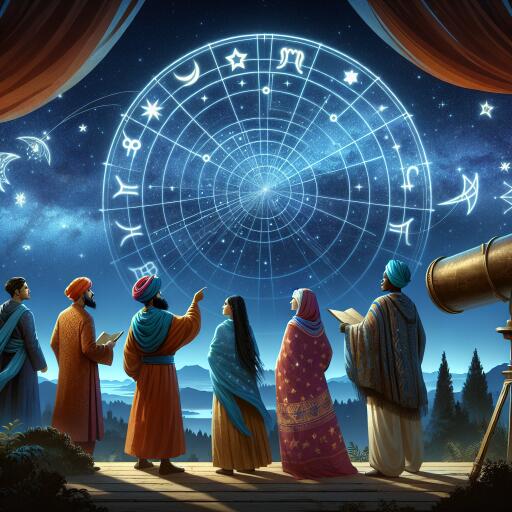The Astrological Influence of Dwarf Planets: Unlocking New Perspectives
The cosmos is an everlasting source of mystery and fascination, not only for astronomers but also for those who seek to understand life’s deeper meanings through astrology. While much attention is given to the sun, moon, and planets within our solar system when it comes to astrological readings and horoscopes, there’s a realm less explored – the influence of dwarf planets on astrological charts. The discovery of these celestial bodies, including Ceres, Pluto, Haumea, Makemake, and Eris, challenges traditional astrological models and invites us to broaden our cosmic perspective.
Understanding Dwarf Planets in Astrology
Dwarf planets are bodies in the solar system that, while orbiting the Sun, possess sufficient mass for their shapes to be controlled by gravitational forces, but have not cleared their neighboring region of other objects. Unlike the main planets, their influence in astrology is subtle yet significant, weaving intricate details into the personal narratives crafted by astrological signs and planetary aspects.
1. Ceres: The Nurturer Among The Stars
Ceres, the first discovered and closest dwarf planet, orbits between Mars and Jupiter within the asteroid belt. In astrology, Ceres represents the nurturing aspect of an individual, focusing on care, sustainability, and relationships with their immediate environment. It brings attention to how we nurture ourselves and others, highlighting the importance of self-care, family ties, and our connection to the Earth. A strong Ceres in a natal chart might indicate a person with a particularly nurturing nature, potentially thriving in caregiving professions or environmentalism.
2. Pluto: Unveiling Transformation and Power
Although reclassified from its planet status, Pluto’s influence in astrology remains undiminished, symbolizing transformation, power, and rebirth. It confronts us with the deepest parts of our psyche, urging us to transmute our deepest fears into our greatest strengths. Located in the Kuiper belt, Pluto’s energy is intense and transformational, often associated with major life changes, destruction leading to renewal, and the subconscious mind. Its placement in a chart can show where and how individuals face challenges of power, transformation, and rebirth.
3. Haumea: Creativity and Fertility
Haumea, with its unique, elongated shape and a ring around it, is named after the Hawaiian goddess of childbirth and fertility. This dwarf planet’s astrological significance is connected to creativity, productivity, and the power of rebirth. Individuals with a prominent Haumea in their charts might find themselves imbued with prolific creative talents or a deep-rooted connection to nature’s cycles, emphasizing growth, renewal, and the feminine aspect of creation.
4. Makemake: Bridging the Material and Spiritual
Makemake, named after the Rapa Nui god of fertility, oversees matters related to material and spiritual prosperity. It is associated with abundance, but also with the responsibility to balance material wealth with spiritual growth. Astrologically, Makemake’s placement often hints at how an individual relates to societal expectations, abundance, and the cultivation of a personal belief system that honors both earthly and spiritual realms.
5. Eris: The Catalyst of Change
The furthermost known dwarf planet in our solar system, Eris, is named after the Greek goddess of discord and strife. Its astrological influence is powerful, often heralding significant change through upheaval. Eris challenges the status quo, forcing us to confront and rectify injustices or inequalities. Paradoxically, it is through Eris’s disruptive energy that the potential for true harmony and balance can emerge. In a natal chart, Eris may point to the areas of life where an individual can expect transformation through conflict, ultimately leading to personal growth and societal progression.
Integrating the Dwarf Planets into Astrological Practice
As astrologers integrate the dwarf planets into their charts and readings, the astrological landscape continues to evolve, offering deeper insights and broader perspectives. The inclusion of these celestial bodies encourages us to consider not just the more apparent influences on our character and destiny, but also the subtler, underlying currents that shape our journey through life.
Including the dwarf planets in astrological considerations allows for a richer, more nuanced understanding of personal and collective cycles. Their influence, while subtle, adds complexity and depth to astrological readings, providing a more holistic view of the cosmos and its impact on our lives. As we delve into the mysteries of these lesser-known celestial bodies, we open ourselves up to new ways of understanding the universe and our place within it.
Conclusion
The astrological domains of the dwarf planets invite us to explore beyond traditional boundaries, offering insights into previously overlooked aspects of our existence. In the grand scheme of the cosmos, these bodies remind us of the complexity and interconnectedness of life, urging us to consider the subtle yet profound ways in which the universe guides and shapes our journey. By embracing the dwarf planets in astrological practice, we unlock new perspectives and possibilities, enriching our understanding of the celestial influences that govern our lives.
The exploration of dwarf planets in astrology is a testament to the field’s adaptability and its perpetual quest for deeper understanding. As we continue to uncover the mysteries of the cosmos, the dwarf planets stand as symbols of the endless potential for discovery, not only of the universe around us but also of the universe within.


